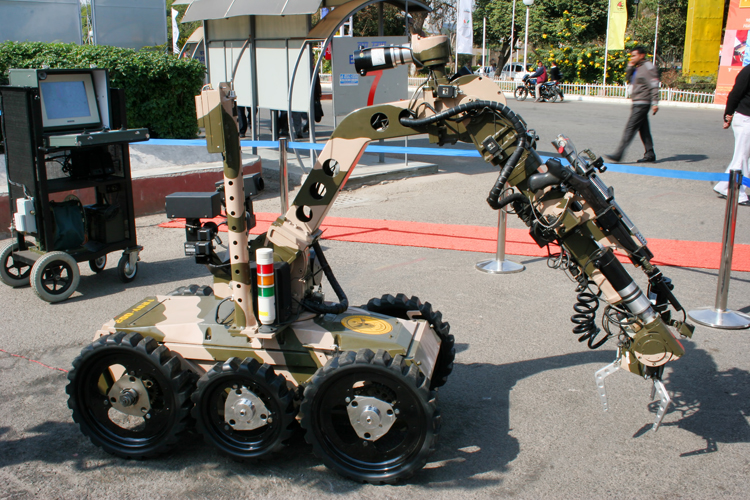INDIAN ARMED FORCES CHIEFS ON
OUR RELENTLESS AND FOCUSED PUBLISHING EFFORTS

SP Guide Publications puts forth a well compiled articulation of issues, pursuits and accomplishments of the Indian Army, over the years

I am confident that SP Guide Publications would continue to inform, inspire and influence.

My compliments to SP Guide Publications for informative and credible reportage on contemporary aerospace issues over the past six decades.
- Interim Defence Budget 2024-25 — An Analysis
- Union Defence budget 2024
- Indian Army: In quest of greater firepower and policy recommendations for gaps
- Indian Army Annual Press Conference 2024
- 6G will transform military-industrial applications
- Tata Boeing Aerospace Delivers 250 AH-64 Apache Fuselages, Manufactured in India
Army to optimise robots
 |
By Lt. General P.C. Katoch (Retd) Former Director General of Information Systems, Indian Army |

As per media reports, MoD has approved a proposal put up by the Army to "build indigenous robots" that are designed to deliver ammunition at targeted locations. This is being touted as a big boost to the anti-terror fight in J&K. The sanction is for 544 robots, as proposed by the Army, under the 'Make' category of acquisition in the Defence Procurement Procedure (DPP) 2016 that stipulates participation only by Indian vendors. According to the report, these "lightweight and rugged" robots will comprise surveillance cameras and transmission systems with a 200m range. The requirement reportedly includes a second unit which can be operated alongside the first unit by a single operator with the same remote (having at least dual display screen) forming part of the system. No doubt such robots will be of immense value for gathering real-time inputs before manual insertion for counter terrorism (CT) tasks especially in built up areas.
There is plenty enthusiasm on the issue but Army isn't getting these robots tomorrow. How soon the elaborate procedures will start with the Request for Proposal (RFP), their examination and so on and so forth, to the project study, identifying the Development Agencies (DA), prototypes, trials, fielding etc is a labyrinth through the red tape that may take months and years. Which private firms will get to participate (some 10 private indigenous firms are driving robotics) other than DRDO that after decades gave the 'Daksh' to the Army for handling Improvised Explosive Devices (IEDs)? But, we need to look around how robots are being used globally for terrorism using commercially-off-the-shelf (COTS) products. The ISIS used COTS drones for surveillance and dropping grenades / bombs causing caution and casualties to Iraqi forces during the battle for Mosul. In 2016, two French Special Forces soldiers were injured and two Kurdish fighters were killed by an exploding ISIS drone.
So, if we are planning robots for surveillance before manual insertion, why not go for weaponized drones to destroy targets instead of always manual insertion? The Aum Shin Rikyo cult that carried out the multiple Sarin gas bombings of the Tokyo subway in 1995 had two remote controlled helicopters that luckily crashed during trial runs, otherwise they had enough Sarin gas to kill one million Tokyoites. Robots can also cause aircraft accidents by coming into the pathway during landings or take-offs. Commercial drones are available in all sizes – from mini to passenger-drones. Dubai is introducing passenger drones this summer that are electrically powered to fly 30 minutes at 100mph. The only control is a touch screen for the passenger to select the destination. The drone flies itself to the destination without human intervention. China had unveiled its passenger drone last year. The passenger drones can carry larger loads for sabotage and terror, suicide bomber (s) included. Mosquito-sized drones for spying and surveillance have been developed in the US.
Japan has developed insect-sized drones as artificial pollinators with coating of horse hair and an ionic sticky gel. The drones work like bees and use their hairs to pick up pollen from one flower and deposit it into another. There could be waves of bees with biological sting attacking targets in not too distant future. Low flying dronse are difficult to battle especially if they are in multiples / waves. At the same time a single drone too is difficult to detect and can cause unimaginable damage. A lone Russian drone reportedly carrying a thermite grenade (combination of iron oxide (rust) and aluminum powder) blew up billions of dollars worth of ammunition last month when it struck the Balakliya military base in Eastern Ukraine (96 kms from the Russia-Ukraine border); the thermite grenade setting off a series of titanic explosions in what has been described as the largest explosions in recent history. This drone attack highlights the growing use of drones, particularly COTS products to undertake wartime sabotage and terror attacks. Guerrilla groups, terrorists, and perhaps even governments worldwide have rapidly weaponized consumer drones, effectively turning hobbyist devices into lethal weapons capable of killing. So, logically, weaponized drones can be used by terrorists anywhere and could happen before the Army gets these robots proposed under the 'Make' procedure, given the enlarging terror threat under the umbrella of the anti-India China-Pakistan collusivity. This should lead us to the conclusion that while the case for 544 robots under the 'Make' procedure is progressing, the Army must examine the use of COTS drones for contending with the hybrid war, not only in J&K but across the board.





